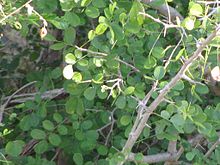Dalbergia melanoxylon
| African blackwood | |
|---|---|
 |
|
| Scientific classification | |
| Kingdom: | Plantae |
| (unranked): | Angiosperms |
| (unranked): | Eudicots |
| (unranked): | Rosids |
| Order: | Fabales |
| Family: | Fabaceae |
| Subfamily: | Faboideae |
| Genus: | Dalbergia |
| Species: | D. melanoxylon |
| Binomial name | |
|
Dalbergia melanoxylon Guill. & Perr. |
|
| Synonyms | |
|
|
Dalbergia melanoxylon (African blackwood, grenadilla, or mpingo) is a flowering plant in the family Fabaceae, native to seasonally dry regions of Africa from Senegal east to Eritrea and south to the north-eastern parts of South Africa. The tree is an important timber species in its native areas; it is used in the manufacture of musical instruments and fine furniture. Populations and genomic resources for genetic biodiversity maintenance in parts of its native range are threatened by over harvesting due to poor or absent conservation planning and by the species' low germination rates.
It is a small tree, reaching 4–15 m tall, with grey bark and spiny shoots. The leaves are deciduous in the dry season, alternate, 6–22 cm long, pinnately compound, with 6-9 alternately arranged leaflets. The flowers are white and produced in dense clusters. The fruit is a pod 3–7 cm long, containing one to two seeds.
The dense, lustrous wood ranges from reddish to pure black. It is generally cut into small billets or logs with its sharply demarcated bright yellow white sapwood left on to assist in the slow drying so as to prevent cracks developing. Good quality "A" grade African blackwood commands high prices on the commercial timber market. The tonal qualities of African blackwood are particularly valued when used in woodwind instruments, principally clarinets, oboes, transverse flutes, piccolos, Highland pipes, and Northumbrian pipes. The timber is used mainly because of its machinability and dimensional stability. Deering Banjo Company uses blackwood ("grenadilla") to construct the tone ring in its John Hartford model banjo. Deering indicates that this reduces weight versus brass/bronze tone rings, and that the wood "plays in" (improves in tone) with use. Furniture makers from the time of the Egyptians have valued this timber. A story states that it has even been used as ballast in trading ships and that some enterprising Northumbrian pipe makers used old discarded blackwood ballast to great effect. The German knife companies Wüsthof and J. A. Henckels sell knives with blackwood handles due to the wood's moisture repellent qualities.
...
Wikipedia

